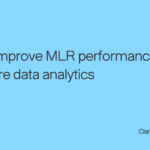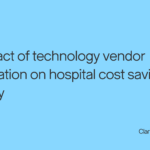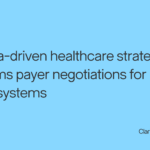Data and analytics are driving healthcare organizations forward. However, with rising economic pressure, IT and data science teams spread thin, and many health systems suffering losses this year, CIOs and data and analytics leaders need to do more with less. Building a growth and value strategy at scale, with speed and precision, requires big data efficiencies, and the ability to draw upon billions of patient journeys. At HIMSS23, Jean Drouin, MD, founder and CEO of Clarify Health, Aasim Saeed, MD, founder and CEO of Amenities Health, Ines Maria Vigil, MD, MPH, MBA, FACPM, SVP Services & Transformation at Clarify Health, and Jake Collins, MD, AVP Enterprise Intelligence, Enterprise Strategy Partners at Atrium Health, held a panel discussion about what type of data is needed to accelerate growth and improve healthcare. Jean Drouin, Moderator How would you describe the ideal data set for building the right growth and strategy at scale and ultimately putting real dollars on the bottom line? Dr. Collins believes one of the biggest challenges is understanding how to build comprehensive data sets that are linked together in a way that gives us a compelling view of what happens to the patient, so that we can build the necessary resources into the care delivery networks. He noted there are a lot of vendors who provide that data separately, but the question is how to get them to work together and make this integration a reality. Dr. Saeed shared that he’s always taken a traditional approach to data sets by aggregating electronic medical records (EMR) data, claims data, and finding ways to incorporate consumer data where applicable, but he says this data does not come together without gaps. Once we’ve uncovered what the patient needs, the next step is to identify how to create behavioral change among physicians. Dr. Saeed underscored the value of partnerships between health systems and vendors to sidestep years-long aggregation mapping projects to glean the necessary insights that would start yet another years-long cycle to begin the process of physician behavioral change. Dr. Vigil thinks it’s crucial to create a comprehensive dataset that’s normalized, governed, and usable. She asks leadership to consider what they want to do with a comprehensive data set—what are the desired outcomes and desired behavioral changes? From there, Dr. Vigil recommended architecting the data with these end goals in mind, to which Dr. Saeed agreed. Dr. Saeed went on to say that leaders in the space need to aggregate better data sets and make them cleaner to reach the right decisions. He proposed that we need to find ways to answer the business, clinical, and financial questions that we have today with the data that we have presently. What are the types of insights that providers require to adopt new tools into their workflow and create differences in patient outcomes? Some tools are complex enough that many administrators and physicians would disengage, so we must find tactics to serve them reports that speak to their level of data proficiency and answer their questions, said Dr. Saeed. Dr. Vigil noted that clinicians need enough information that can back their decision-making up when they take that action with each patient—highlighting that imperfect data works well in these situations. Dr. Collins concurred, interjecting that five fixed statistics are usually enough to help answer clinicians’ questions and act. Dr. Saeed then reframed the conversation, expressing that when many think about analytics data in healthcare, they are likely imagining clinical insights, but there are many other business and operations questions that enterprises are seeking to answer. That said, he pondered why we haven’t placed more emphasis on answering the age-old question: how do I find a good doctor? He noted, “that question is so fundamental and yet we’re just not working on it…before we go find a bunch of data, let’s start with what is that core thing. And again, you may not agree that’s something that probably might be different for a physician or a PA on the floor…But for a consumer that’s the question and we’ve just not answered it because we’ve ignored it for 25, 30 years now.” There are many unanswered questions in healthcare that leaders are seeking to uncover. What are some of the questions you would love to identify clear-cut answers to? Dr. Collins would like to consider what the actual contribution margin of adding a patient in any given space in clinical practices is. He said that it’s challenging to determine if that growth is good in some cases because it’s such a complex question to answer due to the many pieces of data that feed together and the amount of variation present across health networks. As a physician, Dr. Vigil revealed she’s constantly wondering how to achieve the biggest impact possible to patient outcomes by surveilling all the accessible data. She went on to say that she wants to identify a way to leverage this data to optimize patient health and wellbeing in an affordable way. Dr. Saeed took a consumer approach, pondering the benefits of giving patients unfiltered, but readable data. “Just publish it. Just give it to the patients,” he suggested. “They’ll start fixing the healthcare system for us pretty quickly if they just knew data driven insights that you can’t argue against…And things will start to change.” How do you approach balancing the amount of effort on the front end of data management with ROI generation? There are appropriate use cases for historical claims data, as well as for EMR and social determinants of health data, and there are even certain scenarios where all three are important to use an architect, said Dr. Vigil. “Knowing what you’re trying to accomplish, what the goals are, and then architecting the right data sets to do that [is important],” she noted. “But also in the same breath, think like an enterprise. Don’t try to architect each data set as if it was its own unique algorithm because I think that contributes to the lack of interoperability and lack of standards that we see as a problem today across data and across enterprise leaders.” Dr. Collins is a proponent of what he refers to as “curated self-service data,” and stated that we must arm our leaders with the data necessary to answer their questions, and that this is best executed in a curated fashion with data experts involved. He went on to ask, “How do we partner with the leaders who are making decisions to arm them with the data that they need and how do we promote data literacy? That’s a huge point. There’s a big piece of ‘how do we get the right data in the room and how do we make sure that data’s clean and ready to go?’” Dr. Saeed believes that we must prioritize the most necessary use cases rather than tracking the top 20+ metrics which diminishes the emphasis of each metric’s importance. Instead, he said that leaders must pick no more than five metrics to track—with two on the cost side, and two on the revenue side. Building several dashboards with too many metrics leads to data bloat and makes it harder to take action and achieve results. Audience Member: How can we leverage the data and market research to personalize and move the needle to improve care for patients? Leaders are understanding the importance of selecting the top 5 metrics rather than building out several unnecessary dashboards, but how do we pick out what’s most important to the patients we serve? Dr. Saeed shared that a key finding in Amenities Health’s consumer surveys is that availability is of utmost importance to patients, noting the timeliness of availability is the number one priority. He explained that, for the most part, the second important factor is distance, with provider-specific factors ranking below convenience-based factors in the primary care setting. He then added the caveat that specialist-specific metrics are more of interest among patients, and that data-driven insights on mortality, readmissions rates and total cost are key in specialty medicine—noting that companies like Clarify have this information. He went on to say that it’s easy to source this data, but the challenge lies in putting it together in a simple way that doesn’t overcomplicate things. Dr. Collins shared that Atrium Health conducted several focus groups on this topic and collected primary data uncovering that consumers choose care based on convenience. Whether that’s scheduling on a tight turn or distance to the doctor’s office, consumers will be less worried about the clinical quality until you flip the paradigm for them. He added that clinical quality becomes more important when seeking care for others—like a child or parent—so it’s critical to understand the implied subtleties based on how the question is asked. Dr. Saeed interjected to say that the term “clinical quality” has lost its meaning in US healthcare, stating that it’s meaningless to a consumer at this point, and we need to refocus towards measurable factors like mortality, readmission, and cost. Jean concurred, closing out the presentation with an anecdote, “I actually heard an interesting comment the other day around the word “value” (as in value-based care). To the average consumer—it means cheap care. So even the words that we use, to your point, we have to be careful about what they mean to the consumer.”Unlocking value from analytics—do you have the right fuel?
- Author Details





